Learn how to deal with punctures on long rides with prevention tips, repair techniques, and smart gear choices to keep rolling without stress.
HOW DO I FUEL PROPERLY BEFORE SHORT, INTENSE RIDES?
Short, intense rides demand quick access to energy. Whether it’s a criterium, a hill-repeat session, or a 45-minute indoor interval workout, your body relies heavily on carbohydrates for fast-burning fuel. Unlike long endurance rides, the goal isn’t to conserve energy but to deliver high power without crashing mid-session. This guide explains what to eat, when to eat it, and how hydration and supplements fit into the strategy. With the right pre-ride fueling, cyclists can unlock explosive performance while avoiding stomach issues or early fatigue.

The science of fueling for intensity
During short, high-intensity rides, your body shifts to carbohydrate-dominant energy production. Glycogen stored in the muscles and liver becomes the primary fuel, as fat metabolism is too slow to keep up with explosive power demands. Proper fueling ensures glycogen stores are topped off and readily available for immediate use.
If you begin an intense ride under-fueled, performance drops quickly. Low glycogen leads to early fatigue, slower recovery, and difficulty hitting training targets. Unlike long rides where pacing and fat utilization play a role, high-intensity sessions require “front-loading” energy so your body can deliver on-demand power.
Why carbs dominate short efforts
Carbohydrates break down quickly into glucose, fueling anaerobic and aerobic systems.
Muscle glycogen provides immediate energy for repeated surges and sprints.
Adequate glycogen supports better recovery by reducing reliance on protein breakdown.
Hydration also plays a role. Even slight dehydration impairs anaerobic performance, so pre-loading fluids and electrolytes is essential. Together, carbohydrate and hydration strategies prime your body for explosive efforts without compromise.
Practical pre-ride nutrition strategies
Fueling properly before short, intense rides means striking a balance between quick energy and digestive comfort. The timing and type of food matter as much as the total calories. You want fuel that digests rapidly, minimizes gastrointestinal stress, and delivers glucose to working muscles at the right time.
For rides under 90 minutes, a full meal isn’t always necessary. Instead, focus on high-carbohydrate, low-fiber, and low-fat foods that won’t sit heavily in your stomach. Options like white rice, a banana, or a slice of toast with honey are excellent choices. The goal is to avoid foods that slow digestion, such as fatty or protein-heavy meals, which can cause discomfort during maximal efforts.
Fueling guidelines based on timing
2–3 hours before: Eat a light, carb-focused meal (e.g., oatmeal with fruit or a rice bowl).
60 minutes before: Choose a small snack like a banana, energy bar, or slice of toast.
15–30 minutes before: Opt for fast-digesting carbs such as a gel, sports drink, or honey.
Hydration is equally important. Aim to drink 400–600 ml of water with electrolytes in the hours before riding. In hot or humid conditions, add a pinch of salt or an electrolyte tablet to boost sodium levels, preventing early cramping and dehydration.
Caffeine can also be an effective performance booster. Taken 30–45 minutes before the ride (about 3–6 mg per kg of body weight), caffeine sharpens focus, reduces perceived exertion, and enhances sprint performance. However, tolerance varies, so it’s best to test caffeine strategies in training before race day.
By combining quick-digesting carbs, proper hydration, and optional caffeine, cyclists can maximize energy availability and sharpen their edge for intense efforts.
Balancing performance and recovery
Pre-ride fueling doesn’t just affect performance during the workout — it also influences recovery afterward. Adequate glycogen levels at the start of a ride reduce the likelihood of deep depletion, allowing muscles to bounce back more quickly. This means you can train consistently without being sidelined by excessive fatigue.
Cyclists should view fueling as part of a cycle: what you eat before sets the stage for how you perform and how well you recover. Skimping on pre-ride carbs may save a few calories but costs you in reduced training quality and delayed progress. Conversely, thoughtful fueling ensures high-quality sessions that compound into long-term fitness gains.
Best practices for recovery-minded fueling
Start rides with full glycogen stores to minimize deep depletion.
Pair carbs with hydration pre-ride to protect muscle function.
Avoid heavy, fatty meals before intense sessions to reduce digestive stress.
Follow up with a carb-protein snack post-ride to replenish and repair.
Mindset also matters. Many cyclists fear over-fueling short rides, but the cost of under-fueling is greater. Training adaptations come from hitting intensity targets consistently, and this requires arriving at the ride with adequate energy.
In the end, fueling for short, intense rides is about precision. It’s not about large meals but about strategic choices of carbs, fluids, and timing. When done right, you’ll unlock maximum performance while setting the stage for faster recovery and sustainable progress.
YOU MAY ALSO BE INTERESTED






